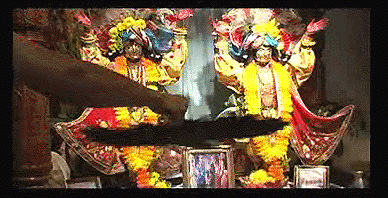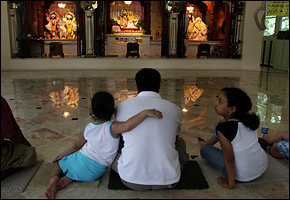

What became of the Hare Krishna devotees whose saffron robes and chanting once graced many a street corner? In the Washington area, they wound up in well-heeled Potomac, an appropriately mainstream location for a movement that has been transformed over its 40 years.
In the mid-1960s, when the movement began on Manhattan's Lower East Side, a Hare Krishna service would have been filled with robe-wearing, twentysomething Caucasian converts, who likely lived at the temple or on an ashram.
Today, the typical worshiper is an Indian American who lives in mainstream America and shows up weekly for services, in khakis and with a kid wearing an NBA tank top along with his tilak (the sacred stripe that Hare Krishnas display between their eyebrows, symbolizing the footprint of God).
At dusk on a recent Sunday, devotees filed into the simple, one-room Hare Krishna temple for worship.
In no time, the service went from zero to 60, with amped-up clay drums whipping up the spirit. Worshipers danced ecstatically in the chairless room, leaping into the air and dropping to the floor and lying prostrate at individually inspired moments. This first part of the service is called kirtan, and it involves the meditative heart of the Hare Krishna faith: chanting. Worshipers sing and chant in Sanskrit and Bengali, a practice they believe helps them attain a higher consciousness and, thus, love of God.
During the kirtan, three priests on a small altar tended to the practice that sets Hare Krishna apart within broader Hinduism: intense deity worship. The priests are part of a team that lavishes attention on three statues all day, changing the statues' clothes and adorning them with fresh garlands of flowers. The statues represent different incarnations of Krishna, a scriptural figure whom Hare Krishnas consider God.
 As the drums and harmonium rocked on, the priests circled the bejeweled brown, gold and white-faced statutes with incense and presented them with gifts of water and orange-yellow flower garlands and peacock feathers.
As the drums and harmonium rocked on, the priests circled the bejeweled brown, gold and white-faced statutes with incense and presented them with gifts of water and orange-yellow flower garlands and peacock feathers.
Soon the room was quiet and people took seats on cushions on the floor for a 30-minute lecture about the nature of happiness and worship.
"This relation between servant and served is the most congenial form of intimacy," said the acting temple president, Anuttama Dasa. As he spoke, a woman spotted an ant scurrying across the floor, scooped it up with her sari and carried it outside.
In another building on the grounds of what used to be a summer camp, young boys practiced for a play commemorating the 40th anniversary of Hare Krishna. It was in 1966 when the Hindu revival movement began, taking the ancient practice of worshipping Krishna exclusively through chanting and turning it into an organized faith system.
In the four decades since Indian guru Srila Prabhupada arrived in New York City to begin spreading the Krishna lifestyle, the movement has changed in many ways.
 Most notable among the changes are the Indian American faces -- 90 percent of worshipers at the Potomac temple, compared with 50 percent in 1980 and 20 percent in 1970s, Dasa said. This is attributable partially to recent Indian immigration to the United States, he said.
Most notable among the changes are the Indian American faces -- 90 percent of worshipers at the Potomac temple, compared with 50 percent in 1980 and 20 percent in 1970s, Dasa said. This is attributable partially to recent Indian immigration to the United States, he said.
After starting the movement in the West, Prabhupada took it back to India, where today there are hundreds of thousands of Hare Krishna devotees.
Another aspect of today's Hare Krishna is that, for the first time, it is multigenerational.
The first, zealous twentysomethings are now in their sixties, and at the Potomac temple, you see their children and even a few grandchildren.
And after the service, they all spread out across the lawn for a vegetarian feast. Soon, the drums began to play.